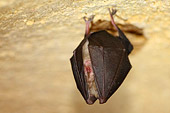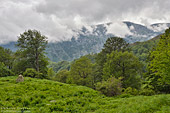Over the years, photography has transformed from a hobby for adventurers, requiring solid knowledge of how equipment is handled and film is processed, into a free-to-all activity that requires little preliminary skill.

Translated by Cenestelle
In our days, you only need to take a walk to the local photo store to choose from the vast diversity of fully automated point-and-shoot cameras and begin to take pictures – there are no film developers, you don’t have to focus manually, and the photos can be viewed immediately on the camera’s screen. But the most important thing, without which even the most advanced camera cannot be of any use, is the photographer’s vision, especially when we’re talking about art photography.
Although this article is about the ways to shoot wild animals and birds, where in most cases proper registration of the object depends on good equipment and preparation, the photographer’s vision still remains a vital factor. Without it, a photo would only be of documentary value. Another significant part of the successful wildlife photography is the rich knowledge of birds and wild animals.
Before you begin to shoot wild animals or birds in particular – as the most difficult to access and exciting orbit that is most likely to sweep you along – it is important to ask yourself several questions. Where am I going to shoot? What am I going to shoot and how? At what time of year can these birds be seen? At what time of day are the species most active?
Without clarity on these, you can walk the hills day after day, without making a single decent shot. I’m claiming this, naturally, from personal experience, because my first steps in bird photography were based on 100% emotion, enthusiasm and no knowledge of diversity of species. At the beginning, it is best to sign up for general educational courses, and then watch the birds’ behavior for some time. When you have made observations and collected knowledge, you can make the first attempts at shooting.
Whenever you shoot birds, it is very important to make sure you are not disturbing them while nesting and that you’re not in proximity to their nest. In such situations birds may, for fear of you, abandon their nestlings or eggs, which can go too cold, or the little birds may die or become prey to small predators. If you have any doubt whether you’ve built up a good approach, you can always ask people with vast experience in the area – ornithologists, ecologists, biologists, etc.
The most valuable “accessory” that you need to acquire before rushing to shoot is camouflage. It is advisable for your clothes to be camouflage themselves – those are offered in hunting/ fishing shops and vary depending on your purpose and, naturally, budget. I personally prefer one that imitates actual branches, leaves and weeds, although the standard “military” type is also very suitable, because it’s universal.
The poncho is a wide-cut 3D camouflage canvas sheet with leaves sticking out of it. This poncho helps a lot to blend into the surrounding environment and facilitates “calming the situation”. Its disadvantage is that it’s made from a thick (although light) artificial fabric, which makes you overly warm in the summer.
The 3D poncho also has a hood, but eye covering is missing, and eyes can also frighten away birds. It is advisable to acquire a special camouflage mesh-like wrap that covers the face and fastens on the nape of the neck with hook-and-loop (stick-on) closure. If you don’t have such eye mesh, at least don’t wear dark eyeglasses – not only do they reflect light from a certain angle, they also look like huge eyes, which scare the bird much more than if you were without them.
While you’re shooting, if possible, it is best to lie on the ground or at least sit down. In case there is a natural obstacle near you – rocks, prickles, bushes, trees – you can press against them. This way you will look least suspicious to the animals and birds around you.
If you’re standing, even with perfect camouflage, the birds will not allow you near, because you will be perceived as a threat. If you lie down in the same place, you will notice that within an hour or two these same birds will be much calmer and come closer, although they will still be fully aware of your presence.
A camouflage hat with a brim and a cloak – again from a filmy camouflage mesh – is very convenient for the summer heat and strong sunlight. Although the mesh is intended to cover the back of the neck, I have very successfully used it back to front – covering my eyes, the upper part of the camera and the lens – thus you don’t have to wrap your face in a separate mesh, and it’s also less uncomfortable.
There are also other more expensive options for 3D camouflage accessories, which are not sold in Bulgaria, but can be delivered if desired. This depends on the photographer’s experience and personal preferences. Another interesting camouflage has a weedy theme. When you put it on, you look like a forest monster :)
I have used it several times and I’m also very satisfied. If you are in a field, you fully blend into the environment. Its disadvantage is that it collects all thorns it touches and is very difficult to move in, especially on a rough terrain, because it keeps getting tangled into bushes and branches.
While you’re shooting, any camouflage is useful, but don’t forget the most important thing – your behaviour. It is extremely important not to make any abrupt movements while you’re taking photos. This applies especially for birds in Bulgaria, which are exceptionally timid because of excessive hunting and poacher raids.
This article is the first one in a series of similar materials dedicated to wildlife photography.
And while we people make sorry attempts to “fool” nature, look at the perfect forms of camouflage that animals have developed. We have yet a lot to learn, right?

Images courtesy of Art Wolfe.

















April 19th, 2011 08:18
Похвално начинание, с нетърпение очаквам и следващи материали. Човек винаги има да научи, особено когато пък и е от “наши хора” :)
April 19th, 2011 11:40
О да, ще има, ще има. Аз редовно ги попълвам/изглаждам статиите, ако нещо съм пропуснал, понеже при писането се допускат грешки или неточности в изказа.
Като ще има статия, нека да е на ниво. Така че като четеш нещо и видиш грешка или друго подобно, свиркай :)
August 16th, 2011 14:05
Здравейте!
Бихте ли написали в следващите статии повече за обективите, които са подходящи за снимане на диви животни. Познавам се с Иво Зафиров и той ми каза, че за да снимам елени, кози и др. обектив 200 мм е бил достатъчен. Или да се ползват думите на Вальо Почекански, че не са важни мм, а близостта до животното.
Поздрави!
August 16th, 2011 20:11
привет,
специално за техниката ще има семинар, на който ще се говори за това.
иначе подробна статия отдавна съм замислил по темата, и нея ще я публикувам като я напиша когато имам време.